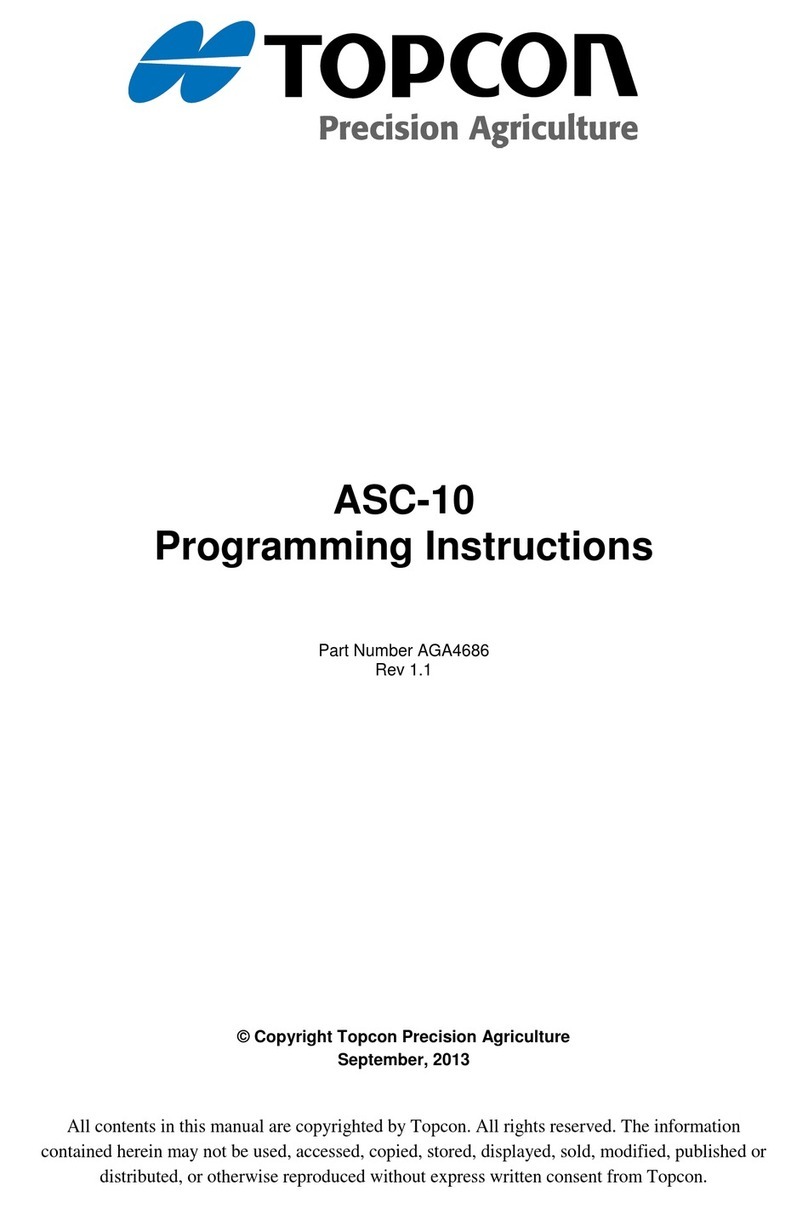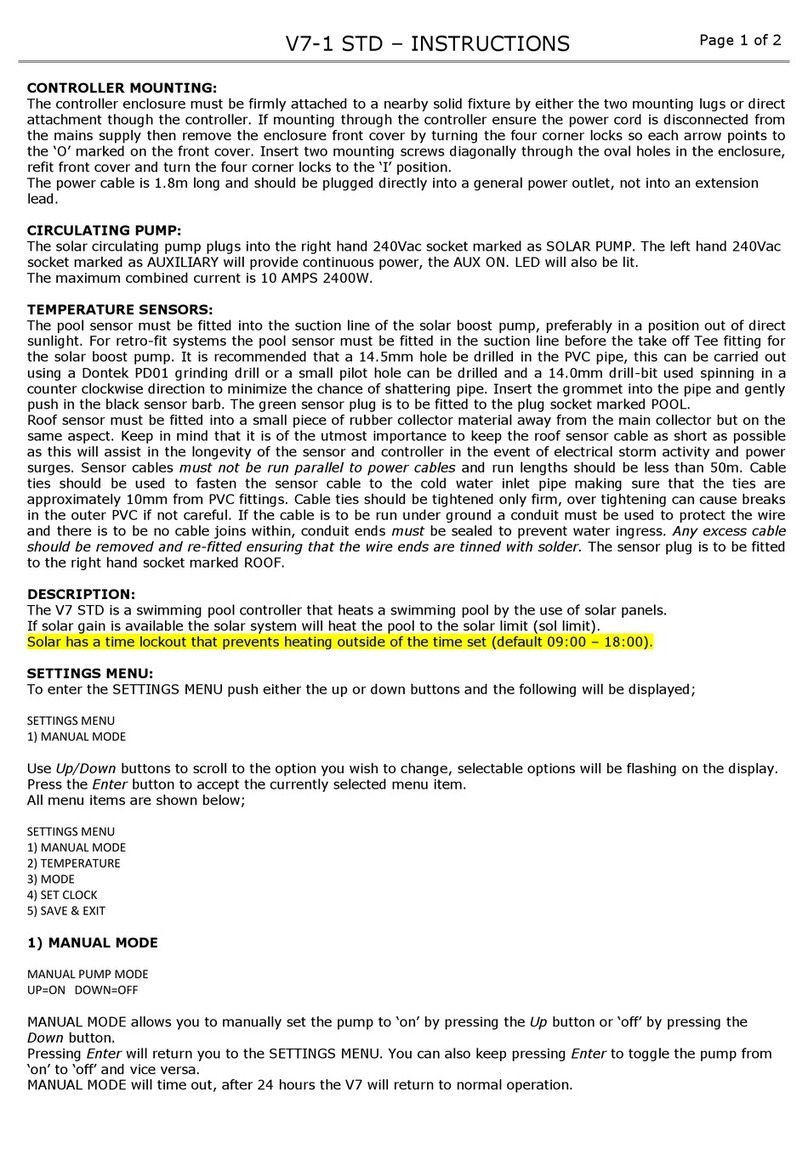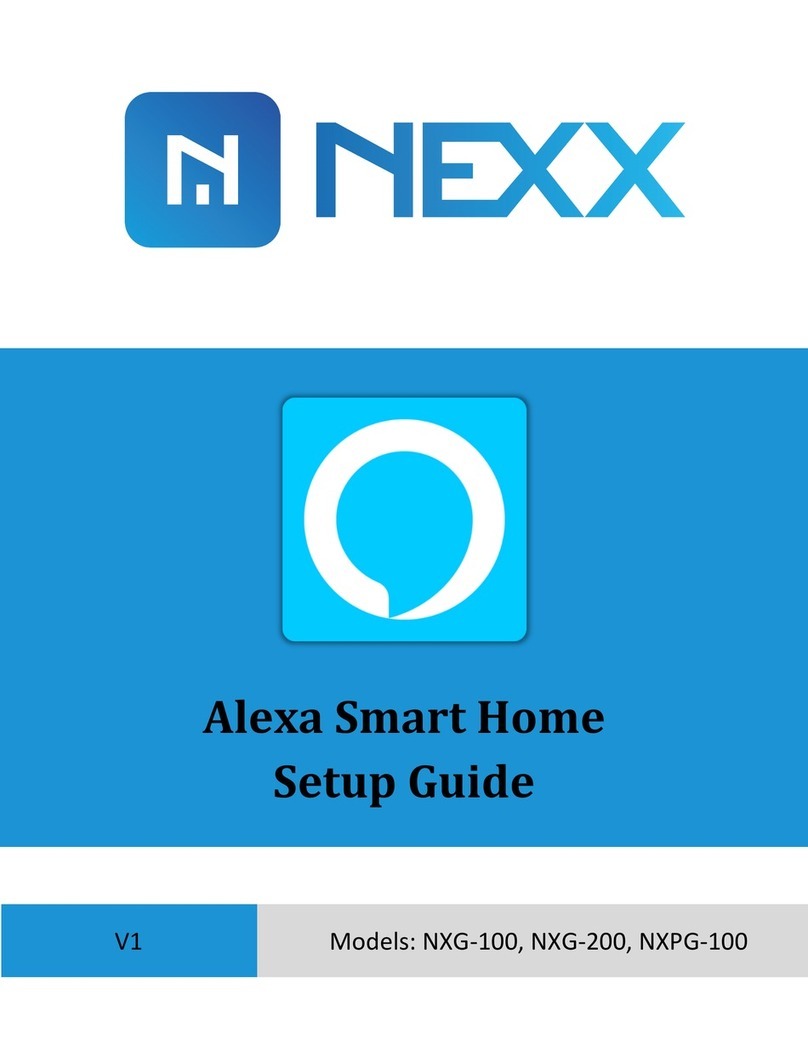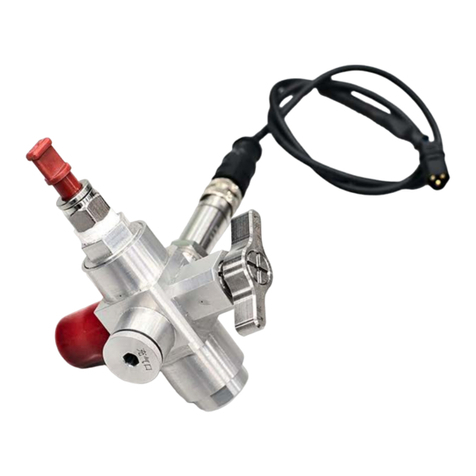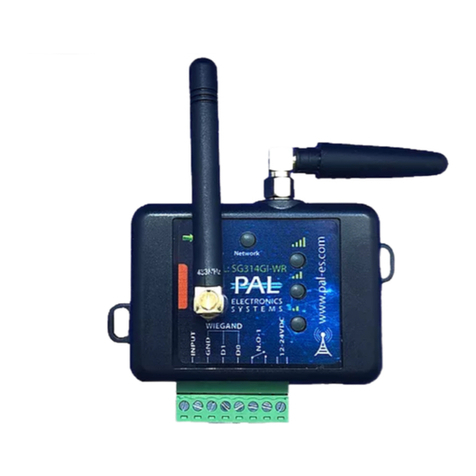INSTROTECH 4004 User manual

Programmable
Load Cell Indicator /
Controller
Operating Manual for Models
Model 4004 / Model 5004

Cleaning
Do not clean the instrument while the instrument is on.
Harsh abrasives, solvents, scouring cleaners and alkaline
cleaning solutions, such as washing soda, should not be
used especially on the display window. The outside of the
instrument may be wiped down with a slightly damp clean
cloth (lightly moistened with water only).
Under no circumstances should you attempt to wipe the
inside of the instrument.
Safety
This equipment is supplied by a mains voltage which can
cause an electric shock injury. Before removing the circuit
board from its housing, switch the instrument off, isolate it
from the mains power supply and make sure that it cannot
be connected inadvertently by other persons.
If the circuit board is removed from its housing, do not
apply power to the instrument unless specifically instructed
to do so in these instructions. When working on live
equipment, exercise great care, use insulated tools and test
equipment, and do not work alone.
When fitting option boards, always put the circuit boards
back in the housing with the back-plate securely fastened
before powering up the instrument.
When handling circuit boards, ensure that full anti-static
precautions are observed.
Replace external mains fuse with one of an equivalent type.
Contents
See last few pages for details of options fitted / available
Introduction ......................................................................... Page 3
Electrical specifications ....................................................... Page 3
Input ranges ........................................................................ Page 3
Load cell excitation............................................................... Page 3
Power supply ....................................................................... Page 4
Programmable specifications ...............................................Page 4
Other specifications ............................................................. Page 4
Installation - Panel Cutout ................................................... Page 5
Installation - Fastening ........................................................ Page 5
Display & keypad during normal display mode ................... Page 5
Display & keypad during programming mode ..................... Page 5
Hardware links & general layout - model 4004.................... Page 6
Hardware links & general layout - model 4005..................... Page 7
Load cell & option connections ............................................ Page 8
RS232 / RS485 option ......................................................... Page 8
Power supply links ............................................................... Page 8
Setup procedure & calibration ............................................. Page 9
Programming chart .............................................................. Page 11
Display codes explained ...................................................... Page 12
Programming example ........................................................ Page 13
Asciibus protocol ................................................................. Page 14
Options................................................................................. Page 15
Option 3000 ............................................................... Page 15
Option 3001-P, 3001-M, 3002, 3003 .......................... Page 16
Option 3004-P, 3004-M, 3006, 3008, 3009..................Page 17
Option 3010, 3012, 3013, 3014...................................Page 18
Option 3016, ...............................................................Page 19
Option 3017-P, 3017-M, 3018-P, 3018-M,................... Page 20
Option 3022, 3025,3026,.............................................Page 21
Option 3029 ............................................................... Page 22
Diagram “P” ......................................................................... Page 24
Diagram “M” ........................................................................ Page 24
Declaration of conformity .................................................... Page 24
Guarantee ........................................................................... Page 24
Page 2

-10 to +10mV (1 mV/V), -20 to +20mV (2 mV/V), -30 to +30mV
(3 mV/V), -100 to +100mV (up to 10 mV/V). See note 1.
Electrical Specifications
Load Cell Excitation
Accuracy & linearity : 0.03% of F.S., or 1 count
Internal resolution (Model 4004) : 20000 counts (bi-polar)
Internal resolution (Model 5004) : 24 bits
Temperature drift : 0.1µV / °C typically
Conversion / settling time : 0.15 secs approx. (no filtering)
Input amplifier impedance : 2 MW (differential)
Operating temperature range : -10 to +50°C
Storage temperature range : -40 to +80°C
Humidity : < 85% non-condensing
Warm-up time : 10 minutes
Electro-mechanical relays : 250V AC, 30V DC, 2A, PF=1
Solid state relays : 400 V AC/DC, 0.5A, PF=1
Analog output accuracy : 0.1% of full scale
Current analog output load : 500 W maximum
Voltage analog output load : 1 kW minimum
Memory retention : Full non-volatile operation
Option 3006 isolation rating : 1500 V
Declaration of conformity : See last page
Introduction
Input Ranges
Sense feedback : Yes
Voltage : ± 5V (bipolar), 10 volts total
Temp. coefficient : 10ppm typical
Max. number of LC's : 1 x 350W load cell (standard)
Max. number of LC's : 4 x 350W load cells (with optional power supply)
NOTE (1) : These 4 input sensitivities cover the vast majority
of applications. For specialised requirements, please consult
the factory.
The Model 4004 is a 4 digit (-1999 to 9999) LED indicator &
Model 5004 is a 5 ½ digit (-199999 to 199999) LED indicator.
These DIN 48 x 96, high accuracy, high-quality load cell
indicators are designed for mV inputs from load cells, strain
gauges & strain gauge pressure transmitters.
The stable bridge excitation voltage includes sense feedback
to compensate for line variations. The precision differential
instrumentation op amp front end input ensures high stability
and accuracy.
Options include programmable voltage or current analog
output, alarm setpoints up to four alarms, tare function (front
pushbutton & remote), peak / valley (max / min) hold, RS 232 &
RS485 serial interfaces & lots more.
A feature of this programmable indicator / controller is the
calibration method. Pre-calibrated ranges can be allocated
zero and full scale values and these can be adjusted on site to
allow for back-balance (deadweight) offset and span
calibration (test weight calibration).
The instrument meets European Community EMC directive
89/336/EEC and Low Voltage directive 73/23/EEC.
Page 3

Programmable Specifications
Model 5004
Zero & full scale setting : -199999 to 199999
Decimal point : Adjustable on all digits
Input sensitivity : Programmable 0 - 10mV/V
Balance range adjustment : 100% of load cell capacity
Tare range adjustment : 100% of load cell capacity
Filtering range : 0 - 10.0 seconds
Options :
Analog output zero & span : -199999 to 199999
Alarm setpoint values : -199999 to 199999
Alarm hysteresis : 0 to 255 (default 1)
Alarm delay : 0 to 255 seconds (default 0)
Alarm relay settings : Selectable HIGH or LOW alarm
Alarm relay state : Selectable NO or NC
Unit address : 1 to 127
Baud rate : 2400, 4800, 9600, 19200
Standard
95 - 265V AC/DC power supply option, 8VA typical
Optional
8 - 30 VDC isolated power supply , 8VA typical (Option 3008)
The standard power supplies provide power for up to four load
cells.
Power Supply
Model 4004
Zero & full scale setting : -1999 to 9999
Decimal point : Adjustable on all digits
Input sensitivity : 1, 2, 3 or 10mV/V
Balance range adjustment : 100% of load cell capacity
Tare range adjustment : 100% of load cell capacity
Filtering range : 0 - 10.0 seconds
Options :
Analog output zero & span : -1999 to 9999
Alarm setpoint values : -1999 to 9999
Alarm hysteresis : 0 to 255 (default 1)
Alarm delay : 0 to 255 seconds (default 0)
Alarm relay settings : Selectable HIGH or LOW alarm
Alarm relay state : Selectable NO or NC
Unit address : 1 to 127 (0 is for factory use)
Baud rate : 2400, 4800, 9600, 19200
Other Specifications
DIN 48 x 96 housing, 147mm depth
Industrial strength single piece housing
Housing is flame retardant ABS plastic that meets UL94 V-0
Circuit board is flame retardant material that meets UL94 V-0
Front facia rating : IP65 (with o-ring seal supplied as standard)
Page 4

Fastening
The supplied fastening
clips may be fitted on
the side or the top /
bottom of the housing.
Ensure that the clip &
screw is mounted as
shown here.
Caution : Do not
overtighen the screws.
Min
12
45
92
Installation
To gain access to the
circuit boards, switch
power off and remove
terminals from the
back of the housing.
Observe safety
precautions. Use a
screwdriver to clip the
back-plate off.
During programming mode Display & Keypad
147
Panel Cutout
Installation
48
96
Enter
Programming menu
Move to next digit
Increment digit / change selection
Alarm LEDs
(illuminated whenever
relays are energised)
48
96
2 3 41
kg
Tare function (option 3014 only)
Print on demand (comms option only)
Reset peak value (option 3012 only)
Toggle peak / normal mode
(option 3012 only)
2 3 41
kg
All dimensions in mm
During normal display mode Display & Keypad
Page 5
O-ring sealing
gasket supplied
as standard
DIN 1/8 cutout
Min
12

Hardware Links & General Layout
Remember : Configuring this instrument requires two steps:
(1) Select the correct hardware links as shown. (2) Program the instrument with the programming chart on page 10.
Page 6
5
7
8
6
9
11
12
10
1
3
4
2
N
L
J4
Select Sensitivity Link
on Circuit Board (Model 4004 only)
Option
board
connector
Up to 3 mV / V
Interposing relays
recommended for
heavy duty
applications
Alarm 1 or Data - (Tx)
Alarm 2 or Data + (Rx)
Alarm Common
+ Sense
- Sense
Remote peak / valley hold reset
Neutral (+ DC supply input)
Ground (common)
Live (- DC supply input)
+mV input
DISPLAY BOARD
+ Excitation
- mV input
Up to 2 mV / V
Up to 1 mV / V
Up to 10 mV / V
Remote tare
- Excitation
J1
J2
Model 4004

5
7
8
6
9
11
12
10
1
3
4
2
N
L
J4
Select Excitation Link
on Circuit Board (Model 5004 only)
Option
board
connector
Alarm 1 or Data - (Tx)
Alarm 2 or Data + (Rx)
Alarm Common
+ Sense
- Sense
Remote peak / valley hold reset
Neutral (+ DC supply input)
Ground (common)
Live (- DC supply input)
+mV input
DISPLAY BOARD
+ Excitation
- mV input
A and C is 10V excitation
Remote tare
- Excitation
J1
Model 5004
ABC
3.3 V excitation(Link A only)
5.0 V excitation(Link C only)
Hardware Links & General Layout
Page 7
10V excitation(Link A and C)
Interposing relays
recommended for
heavy duty
applications

No links.
RS232 / RS485 Option
Load Cell & Option Connections
1. - mV
3. + Exc
4. +Sense
7. Reset
5. - Sense
2. + mV
8. Tare
9. DGND
10.
6. - Exc
Neut (+)
11. - D(Tx)
12. +D(Rx)
Live (-)
Circuit board
Alarm connections
for option 3001/4-P only.
Solid state relays,
400V AC/DC,
0.5 A max, PF=1
Interposing relays
recommended for
heavy duty applications
Link Sense to Excitation
if remote sense is
not used.
Remote tare (option 3014)
Place hardware links as shown in the diagrams.
Remember : Configuring the 4004 requires two steps. (1) Select the
correct hardware links as shown. (2) Program the instrument with
the programming chart on page 10.
Power Supply Links
If the RS232 or RS485 option is ordered, then
the alarm relays can be found on the option
card that slots in the top part of the housing.
See diagram “P” or “M” on the last page.
For RS485,
use pins 11 & 12.
For RS232,
use pins 9, 11, 12.
Alarm 1
Alarm 2
Alarm com
9. DGND
10
11
12
Remote peak / valley hold reset (option 3012)
Page 8

The load cell can be pre-calibrated by entering the zero and load cell full scale capacity in the programming menu. The load cell
system zero value can normally left at 0 for the pre-calibration. The load cell full scale capacity is then entered.
Example 2:
For a 3 x 1000 kg load cell system with 2mV/V each.
Carefully remove the circuit board from the housing and link for
2mV/V on jumper J4 (see step 1 above).
Program the instrument as follows:
- Go to the “Inp” and “Cal” menu.
- Set “2 mV” which represents the load cell sensitivity.
- Set decimal point to “oooo” (no decimal point).
- Set load cell “zero” to “0”.
- Set "LC.FS" to "3000" (as there are 3 x 1000 kg load cells).
The system has now been pre-calibrated.
Setup Procedure & Calibration
REFER TO THE PROGRAMMING FLOW CHART on page 10 while using this setup procedure.
This instrument offers an easy & straightforward way to pre-calibrate and field calibrate the load cell system. Follow the steps below:
Step 1 : Setting instrument sensitivity
The load cell sensitivity must be set in via jumper link J4 on the circuit board (see circuit board layout diagram on page 6). The
sensitivity setting must also be set in the programming menu (use the programming chart on page 10 to assist you, as well as the
examples below). If the load cell system sensitivity is not exactly one of the pre-determined ranges of 1mV/V, 2mV/V, 3mV/V or
10mV/V, then use the next highest sensitivity. E.g. if the load cell sensitivity is 1.6mV/V, then use the 2mV/V range. Remember to set
the sensitivity link (J4) on the circuit board as well.
See example 1 and 2 below.
Example 1:
For a 1 x 5.000 ton load cell that has a 3mV/V sensitivity.
Carefully remove circuit board from the housing and link for
3mV/V on jumper J4 (see step 1 above).
Program the instrument as follows:
- Go to the “Inp” and “Cal” menu.
- Set “3 mV” which represents the load cell sensitivity.
- Set decimal point to "o.ooo” (three decimal places).
- Set load cell "zero" to "0.000".
- Set load cell full scale capacity "LC.FS" to "5.000".
The instrument has now been pre-calibrated.
Step 2 : Entering the decimal point, the load cell zero, and the full scale capacity value
Page 9

Once steps 1 - 4 above have been completed, the instrument automatically alters the pre-calibration parameters “Zero” and “LC.FS”
in the “CAL” sub-menu (entered in step 2 above). These altered parameters may not resemble the original values entered by the user.
This is normal as these parameters fully characterise the weighing system.
DO NOT change these parameters. It is suggested that these parameters be noted for future use, especially if the instrument is
replaced. These parameters can be re-entered into the new instrument with the result that reasonable accuracies can still be obtained
without re-doing a field calibration. This is especially useful when minimum downtime is critical, and to avoid wastage if failure occurs
when the bin / hopper still contains materials. It is still recommended that complete field calibration is done when the situation permits.
Step 5 : Store away calibrated instrument parameter for future use
Make sure that steps 1 & 2 on the previous page have been completed before proceeding with step 3.
The following procedure removes the deadweight from the weighing system (which is normally the bin / hopper / scale weight), and
returns the display reading to show zero with the bin empty.
Make sure that the bin / hopper is empty. Use the programming chart to go to “Inp”, followed by “Tare”. Press enter. The display will
flash “Tare” indicating that the instrument is measuring and averaging the bin weight. Allow for a few seconds of averaging, then press
the enter (star) button to stop the process. The instrument will exit programming mode and the display should read zero.
Step 3 : Field calibration of load cell system for back-balance (deadweight)
Make sure step 3 above has been completed before proceeding with step 4.
The following procedure allows the weighing system to be accurately calibrated using test weights.
Place the test weights on the bin / hopper / scale. The instrument should read the weight of the test weights. If the reading is not of
sufficient accuracy, then use the programming chart to go to "Inp", followed by "LOAD" and press enter. The instrument now prompts
you to enter the weight of the test weights. Then press enter. The display will flash “LOAD” for a few seconds, indicating that the
instrument is measuring and averaging the tests weights in the bin / hopper / scale. The instrument automatically exits programming
mode after a few seconds.
Step 4 : Field calibration of span (test weight calibration)
Page 10

Page 11
RS485 / 232
only (Option
3002 / 3013)
, , , ,, , , ,
, , , , ,
, , , , , , , , , , , ,
,
, ,
,
,
, , ,
READ ME FIRST !
,
, , , , for menu
(Similarly for alarm 2, 3 & 4)
“END”. Instrument returns to normal display mode.
to accept
new value
, ,, , ,,
,
,, , ,
Tare,
Peak / Valley
hold only
(3012 / 3014)
Analog output
only (Option
3003 / 3007)
Alarms /
setpoints /
only (Option
3001/4/17/18)
Keypad lock
only
(Option 3025)
START
HERE
Programming Chart
(Similarly for alarm 2, 3 & 4)
Alarms /
setpoints /
only (Option
3001/4/17/18)
, ,,,, ,
, ,, , , , ,,, ,
,, , , , , ,,
,
,, ,
Automatic exit from menu after a few seconds
NOTE : "incr” on Model 5004 only
,,
, , ,,
Allow a few seconds of tare averaging.
Then press the “star” key.
,
,
,
,
Note 1 : This programming chart is a simplified flowchart for users that have previous experience with this instrument. A programming example is
available in the next few pages to assist new users in understanding this programming chart.
Note 2 : Because this instrument has many options, all possible option menus are shown. Options that are not ordered will not appear in the
programming sequence.
Note 3 : Configuring this instrument requires two steps. (A) Select the correct hardware links (page 6). (B) Program the instrument with this chart.
Note 4 : To enter programming mode, press the menu key for a few seconds (unless the optional keypad lock has been set). Programming mode timeout
is about 20 seconds. If no key is pressed for 20 seconds during programming, the instrument returns to normal display mode.

Output selection (0-10V, 0-20mA, 4-20mA)
Analog output menu
Turn the tare feature on or off
Protocol selection. On = AsciiBus. Off =
DigiBus.
Input & calibration sub-menu
Output zero selection
Output full scale selection
Unit address (default 0)
Display Codes Explained
1st, 2nd, 3rd, 4th setpoint value
Alarm configuration menu (shown for 1st alarm only)
1st alarm setpoint select HIGH / LOW alarm
1st alarm setpoint normally OPEN / CLOSED contact
1st alarm setpoint hysteresis
1st alarm setpoint delay
Communications menu (RS232 / RS485)
Peak / valley hold selector
If “off”, peak hold mode. If “on”, valley hold mode
Available baud rate values
Tare feature select (auto-zero / auto-tare)
Peak / valley hold feature (min / max hold)
Option menu for Tare feature and Peak / Valley Hold
Turn the peak / valley hold feature on or off
Hardware overrange. Reduce input signal to reduce saturation.
Process overscale. Input has exceeded full scale value. / Display test mode.
Keypad lock security menu. See Option 3025 more information.
Keypad lock security level. Level 0 = none,
Sub-menu for manual setting of deadweight / back-balance and load cell capacity (pre-calibration).
Sub-menu for field calibration of deadweight / back-balance. Press the “star” key to start process.
Sub-menu for field calibration of span using test weight method. Set to test weight value and press
the “star” key to start process.
During field calibration of deadweight / back-balance, display flashes “tare” until the “star” key is
pressed.
During field calibration using test weights, display flashes “load” until the “star” key is pressed.
Load cell sensitivity (up to 1mV/V, up to 2mV/V, up to 3mV/V, up to 10mV/V.
Load cell (display) decimal point selection (non-floating point)
Model 5004 only. Display increment. Value range is 0 - 100. e.g. "10” would give a dummy zero.
Manually entered back-balance (dead weight) value (enter as positive value)
Manually entered load cell full scale capacity (e.g. enter 1000 for a 1000 kg load cell system)
Load cell input filter with a range of 0 to 10.0 seconds. Default is 0.0.
Page 12
Lineariser option
Turn the linearsier feature on or off
The number of points to linearise the curve
. . . 2 - 16 points
Actual displayed value
Linearised displayed value

Page 13
Remember, the symbols on the keypad have the following
Press “Menu” for
3 seconds
Press “Increment digit”
to increase value
Press “Enter” to see
Alarm / Trip 1 value.
Amend the other digits in the same way until the desired trip
value is entered.
The entire programming menu operates in a manner
similar to the example described above.
Next Menu
Item Increment digit Next Digit Enter /
Accept value
Press “Next digit” to
amend the next digit
Press “Menu” to
proceed to next
trip value.
Press “Enter” to accept
Alarm 1 value.
Setting Up Alarm Values (Option)
Programming Example
Use the same menu steps above to change trip levels
for trip 2, 3 and 4.
Continued
Clock
On / Off
Time
Hour, Minute, Second (24 hr mode)
Date
Day, Month, Year
Display Codes Explained

Page 14
IGNORE THIS PAGE unless communications option has been ordered. When the RS232 (option 3013) or RS485 (option 3002) is
ordered, two protocols are made available, namely ASCIIbus & DIGIbus protocols. DIGIbus is the default protocol which is used for
the calibration and configuration of the instruments, and whenever the instrument is connected to master-slave systems. DIGIbus
protocol is therefore used in complex bus systems, and is NOT described here. Please contact factory for the DIGIbus protocol.
ASCIIbus, which is described here, is much easier to use as it can easily interface to third party systems with very little engineering
work required. It is a purely ASCII based (7 bit) protocol. The protocol is essentially designed for one way communications
(instrument to PC). Under the "Conn" (connection) programming menu, ASCIIbus is enabled by selecting "ASCI" to "ON". If "OFF" is
selected, the DIGIbus protocol will be active. Although designed for one way communications only, the ASCIIbus protocol contains an
address. The address range is "00" to "99".
Using address "00" : If this address is selected, the instrument will only transmit data on demand by either momentarily pressing the
'menu' key, or by transmitting a byte (any ASCII character) to the DPM. This mode is useful for interfacing to printers. In addition, field
' A A ' will contain the ASCII character "blank/space". Field ' P ' will also contain the ASCII character "blank/space".
Using address "01" to "99". If any of these addresses are used, the meter continuously transmits information at approximately 5 times
a second.
The data format string output from the indicator is (7 bit ASCII code is used):
Line Settings : 7 Data Bits, 1 Parity bit, Odd Parity, 1 Stop Bit.
Baud Rate : Selectable 2400, 4800, 9600, 19200.
Data Bits : Numerical ASCII characters : 0, 1, 2, 3, 4, 5, 6, 7, 8, 9
Other ASCII characters : #, blank/space, +, -, CR, LF
Protocol format is : # A A S D D D D D D D D P CR LF
where : # = indicates start of message
: A A = Instrument address. ASCII 00 to 99. 00 is default.
: S = sign (polarity) ( ASCII "+" or "-" ).
: D = data bits (data for 8 numerals). See Note (1).
: P = decimal point position. ASCII 0 to 8.
: CR = ASCII carriage return.
: LF = ASCII line feed.
The output will follow the display reading. This
means that if the peak-hold option has been
ordered and activated, the communications output
will peak-hold as well.
Note 1 : This protocol allows for future expansion.
Therefore if Model 4001 is used for example, the
first four digit data will contain the ASCII character
"blank/space" and the last four digits will contain
the display reading. Similarly, if the Model 5001 is
used for example, the first 2 digit data will contain
the ASCII character "blank/space" and the last six
digits will contain the display reading.
Asciibus Protocol (for Option 3002 / 3013)Communications

Page 15
The lineariser option is used for non-linear input signals. A 16 point straight line approximation lineariser is provided. The user can enter any number of
points from 2 (Linear input signals) to 16. The greater the number of points, the greater the accuracy of the linearisation. Every actual display point has a
corresponding linearised display point.
Analog output
only (Option
3003 / 3007)
Keypad lock
only
(Option 3025)
Option 3000 Lineariser (Model 5004 only)
DISPLAY CODES EXPLAINED
PROGRAMMING CHART
On
Lineariser
Off
Number of Linearisaton Points
Actual Display Value
Linearised Display Value
Linearisation points
NOTE:
- If the input signal is beyond the limits of the last actual point entered then the unit will calculate the slope between the last 2 actual values and
use this to calculate the required linearised display.
- Do not enter the same actual value for 2 or more points. The unit will compare and select the first sequential point in memory and use this.
- The lineariser points is a mirror image for negative input signals.
SETUP:
- The instrument must be setup and calibrated as instructed in the manual.
- The user must then apply test signals and record the actual readings on the display.
- The user must then activate the lineariser and enter the actual reading with the
corresponding desired reading.
- The instrument can be checked by applying the original test signals and verifying the
display.

See page 7 for connection details. Select DIGIbus or ASCIIbus protocol from the program menu. See additional protocol documents.
0 - 20mA / 4 - 20mA / 0 - 10V Analog Output OptionOption 3003
RS485 Communications OptionOption 3002
Two Setpoint Alarms (Electro-Mechanical Relays)Option 3001-M
Two Set Points (Solid-State Relays)Option 3001-P
See page 7 for connection details. However, if option 3002 / 3013 is also fitted, then the relays are fitted on an option board that slots
into the upper slot of the panel meter box (terminals numbered 13-28). See diagram “P” on page 20 for the relay connections. Wire for
AL1 & AL2 only.
This option is provided on an option board that slots into the upper slot of the panel meter box. The upper terminals are clearly
numbered 13-28 to differentiate them from the lower terminals. See diagram “M” or “P” on page 20 for wiring details.
This option provides two alarm setpoints with electro-mechanical relays. This option board slots into the upper slot of the panel meter
box. The upper terminals are clearly numbered 13-28 to differentiate them from the lower terminals. Both normally open and normally
closed contacts are provides with each relay. The relays are rated at 250VAC / 30VDC @ 2A. Visual LED alarm indication is provided
on the panel meter front. For connection wiring details, see diagram “M” on page 20. Connect wires for AL1 & AL2 only.
Page 16

Page 17
This is ordered with option 3002, 3003, 3007 or 3013. It provides a minimum of 1500V isolation between input and output signal.
Wiring connections are different for these isolated options. Use diagram “P” or diagram “M” on page 20 for wiring connections.
Isolated Options (Analog Output / RS232 / RS485)Option 3006
See page 7 for connection details. However, if option 3002 / 3013 is also fitted, then the relays are fitted on an option board that slots
into the upper slot of the panel meter box (terminals numbered 13-28). See diagram “P” on page 20 for the relay connections. Wire for
AL1 only.
One Setpoint Alarm (Electro-Mechanical Relay)Option 3004-M
One Setpoint Alarm (Solid State Relay)Option 3004-P
This option is similar to option 3001-M described above, but offers one alarm relay only. See option 3001-M above for more
information, but wire for AL1 only.
This power supply option provides 8 - 30V DC supply isolated. See page 7 for connection details. This option also provides excitation
for up to four load cells.
Galvanic Isolation (8 - 30V DC Supply) OptionOption 3008
Parallel BCD Output OptionOption 3009
This option is supplied as an additional slot-in card in the top part of the instrument housing. See the additional documentation. Note
that this option cannot be used in conjunction with any of the alarm setpoint options, nor with the bar graph display option.

Page 18
See the additional documentation supplied for protocol details & page 7 for connection details. Ensure that maximum cable length
from instrument to PC is less than 15 metres.
RS232 Communications OptionOption 3013
This options allows the instrument to operate from a wide range of AC & DC power supplies. The supply connections are on page 7.
This option also provides excitation for up to four load cells.
Peak Or Valley (Max or Min) Hold OptionOption 3012
95V-265V AC / DC Power Supply OptionOption 3010
This option displays and holds the maximum or minimum value (not both) of an input signal. This option is activated in the
programming menu “Opt” by selecting whether “Hold” should be “On” or “Off”, and selecting whether valley (”valy” = “On”) or peak
(”valy” = “Off”) hold should be displayed.
The display can be toggled to show the peak / valley value or normal value by toggling the “up” arrow key (press for about 3 seconds
each time). For rapid response to step changes on the input, ensure that the filter in the programming menu is set to 0.0. To reset the
peak / valley hold value, press the “side” arrow key for 3 seconds, or use an external potential free contact (see page 7 for connection
details). If analog output option is fitted, the output will hold as well.
This option allows the operator to zero the display at any time and continue the measurement from that point in time. This option is
activated "ON" or "OFF" in the "Opt” menu during programming (see page 10).
During normal operations, pressing the “star key” for 3 seconds will zero the display. The display can also be zeroed via an external
potential free contact (see page 7 for connection details). The display can be zeroed at any time over and over again.
If the analog output option is fitted, the output will follow the display.
Tare / zero functionOption 3014

Page 19
6 Load Cell Booster
Option 3016
Earth
Neut
Live
1347
5
28 9 106 11 12 13
- Ex In
This loadcell booster is capabable of
providing excitation for six loadcells.
3016 Booster
Terminals
+Ex Out
GND
+Ex In
+Ex Out
+Ex Out
+Ex Out
- Ex Out
- Ex Out
- Ex Out
- Ex Out
- Ex Out
+Ex Out
1347
5
28 9 106
E
11 12
LN
13
1347
5
+Sig
8 9 106 11 12
E L N
Model
4004 /
5004
L N
NLE
AC supply
2
-Sig
-Ex
+Ex
+Ex
+Ex
-Ex
-Ex
This option is a separate DIN-rail mount external power supply to provide excitation for up to 6 x 350W load cells. Wiring instructions are
shown on the option housing and also on the diagram on the right. If only four load cells are used, then Option 3010 is recommended.
Option 3016 label -
connections to indicator

Page 20
Three Alarm Setpoints (Electro-Mechanical Relays)Option 3017-M
This option provides three alarm setpoints with solid state relays. This option board slots into the upper slot of the panel meter box.
The upper terminals are clearly numbered 13-28 to differentiate them from the lower terminals. Only normally open contacts are
provided, which means that should the contacts be closed and the power fails, they will revert to a normally open condition. The
relays are rated at 400V AC /DC @ 0.5A. Visual LED alarm indication is provided on the panel meter front. For connection wiring
details, see diagram “P” on page 20. Connect wires for AL1, AL2 & AL3 only.
This option provides three alarm setpoints with electro-mechanical relays. This option board slots into the upper slot of the panel
meter box. The upper terminals are clearly numbered 13-28 to differentiate them from the lower terminals. Both normally open and
normally closed contacts are provides with each relay.The relays are rated at 250VAC / 30VDC @ 2A. Visual LED alarm indication is
provided on the panel meter front. For connection wiring details, see diagram “M” on page 20. Connect wires for AL1, AL2 & AL3 only.
Three Alarm Setpoints (Solid State Relays)
Option 3017-P
This option is similar to option 3017-P, but contains four relays (see option 3017-P). For connection wiring details, see diagram “P” on
page 20. Connect wires for AL1, AL2, AL3 & AL4.
Four Alarm Setpoints (Solid State Relays)Option 3018-P
This option is similar to option 3017-M, but contains four relays (see option 3017-M). For connection wiring details, see diagram “M”
on page 20. Connect wires for AL1, AL2, AL3 & AL4.
Four Alarm Setpoints (Electro-Mechanical Relays)Option 3018-M
This manual suits for next models
1
Table of contents
Popular Controllers manuals by other brands
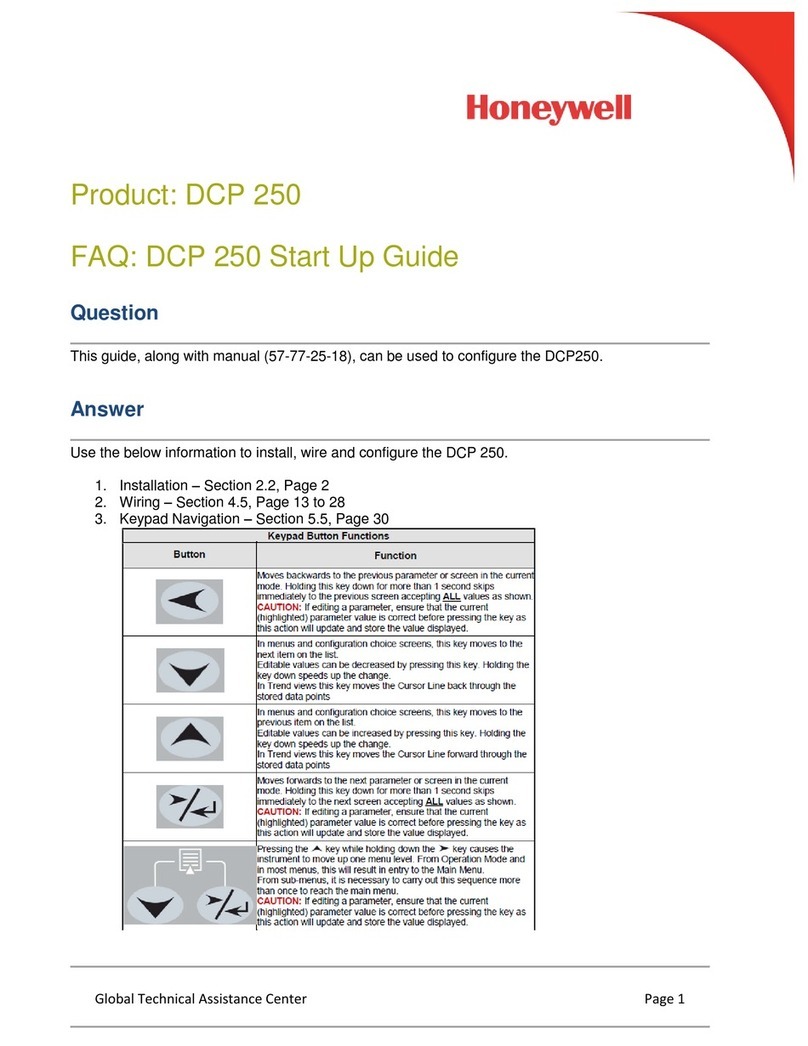
Honeywell
Honeywell DCP 250 Faq
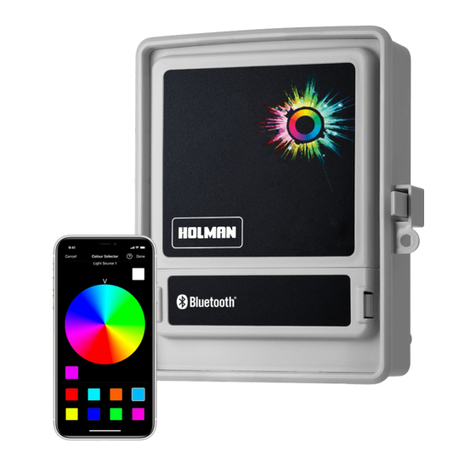
Holman
Holman CLW60 user guide
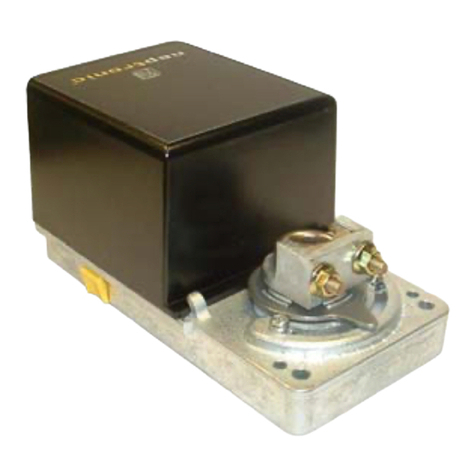
Neptronic
Neptronic BBTHV1100A Specification & installation instructions
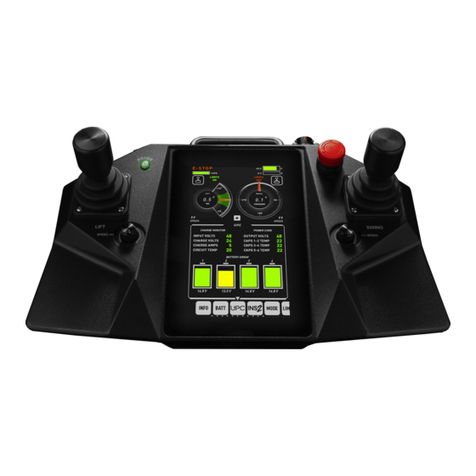
MotoCrane
MotoCrane COMMAND CONSOLE PRO Operation manual
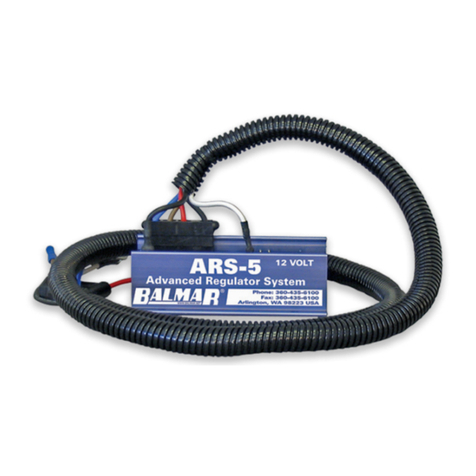
Balmar
Balmar ARS-5-H Installation and operation manual

Alto Professional
Alto Professional StageDrive+ quick start guide
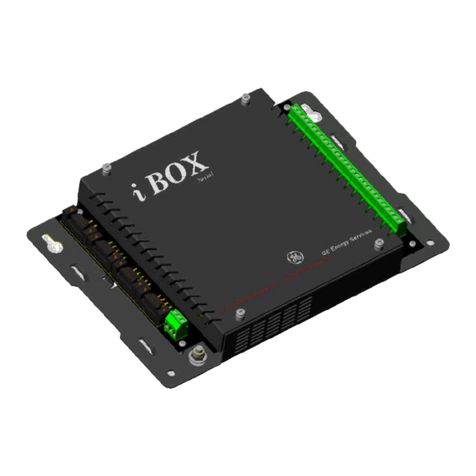
GE
GE iBox Installation and maintenance guide
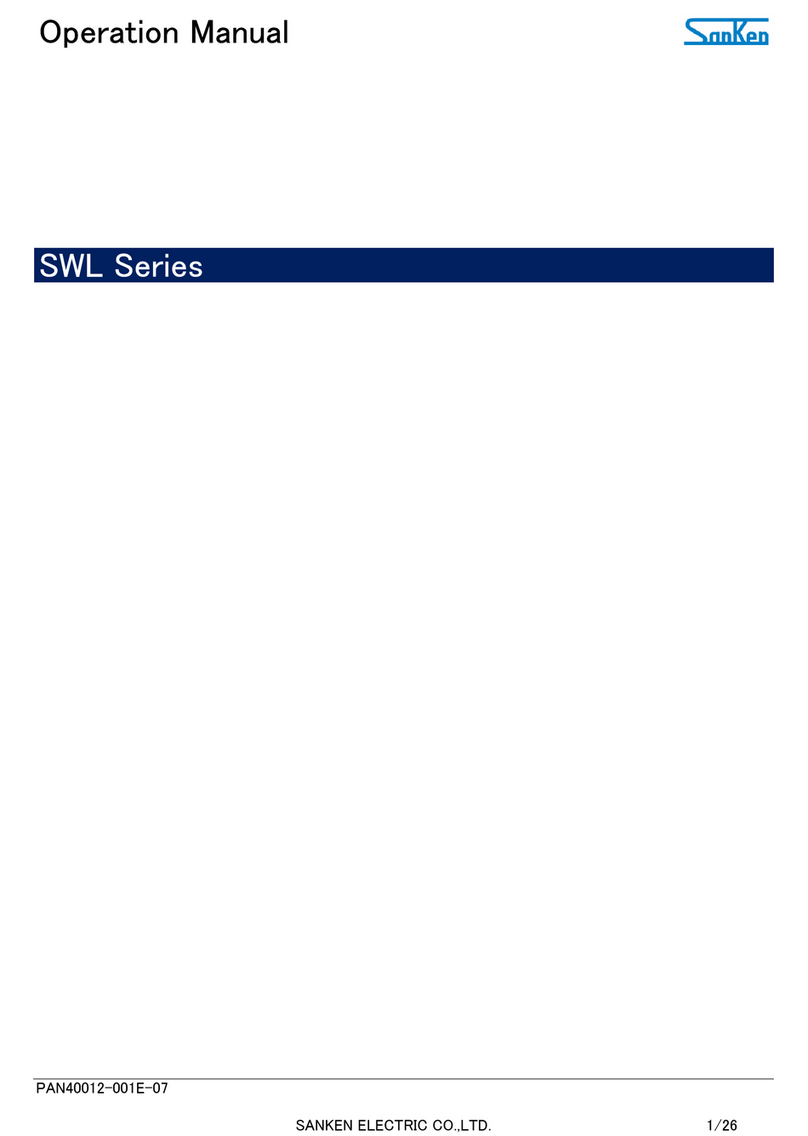
Sanken
Sanken SWL Series Operation manual

Danfoss
Danfoss VLT HVAC Drive FC 102 operating instructions
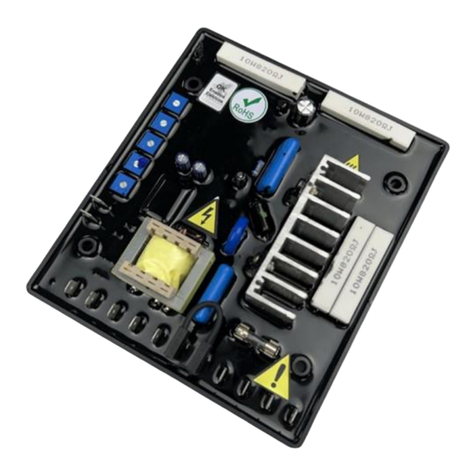
WEG
WEG GRT7-TH4E Installation, operation and maintenance manual
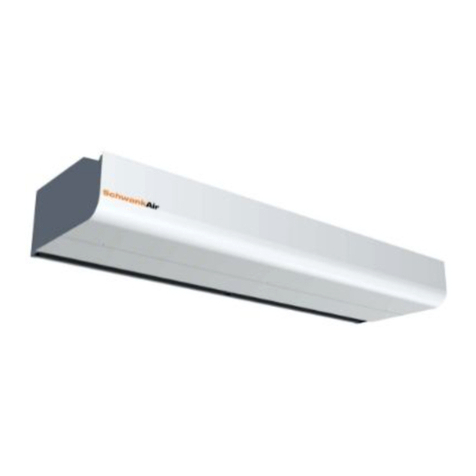
Schwank
Schwank SchwankAir 4000 Series instructions
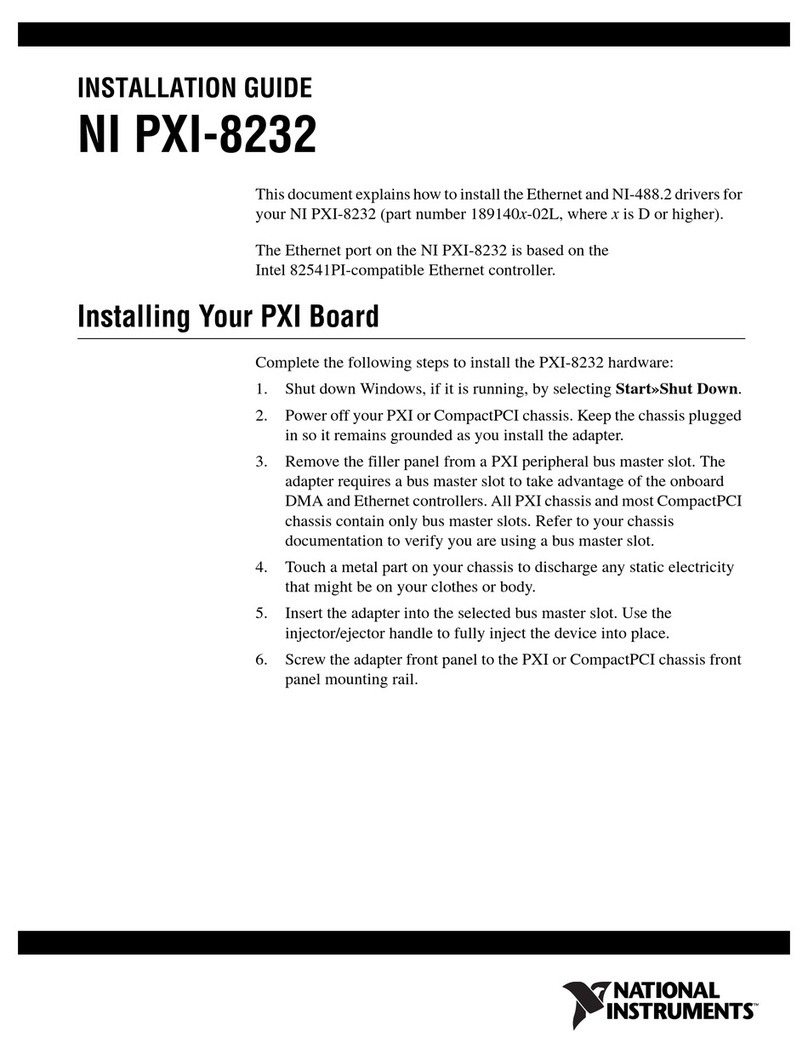
National Instruments
National Instruments PXI-8232 installation guide
